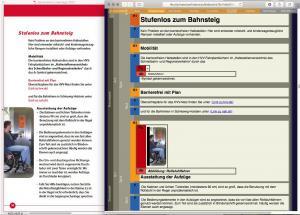
How accessible is the documentation these days?
Today’s world of Information Technology has opened the doors in many ways in order to integrate people with disabilities into our society. But there are a number of prerequisites that need to be met. PDF/UA standard for reading and editing documents and forms serves the same purpose to barrier-free PDF as served by a flattened curb or a stepless access to a wheelchair user. In PDF/UA (= Universal Accessibility), the specifications for barrier-free PDF documents are defined as an ISO standard. Wi … Read more
 Today's world of Information Technology has opened the doors in many ways in order to integrate people with disabilities into our society. But there are a number of prerequisites that need to be met. PDF/UA standard for reading and editing documents and forms serves the same purpose to barrier-free PDF as served by a flattened curb or a stepless access to a wheelchair user. In PDF/UA (= Universal Accessibility), the specifications for barrier-free PDF documents are defined as an ISO standard. Without limiting the diversity of PDF technology, it defines how unrestricted accessibility of content in PDF files is ensured. To this end, the PDF/UA standard defines specifications to exclude barriers to access page content, form fields, annotations, metadata and other elements of PDF files. This allows these users, who normally use special tools, to interact with the content in PDF documents. For the author, PDF/UA offers clearly defined criteria that must be observed when creating barrier-free documents. You might be wondering that how is it a value addition for all then? Barrier-free documentation does not only concern people with more or less severe disabilities. A PDF tagged with a clean tagging structure is generally an improvement. For example, search engines can index barrier-free PDFs much better. Structured PDF files are also easier to reuse than traditional documents, for example when converting to HTML. In addition, content from tagged PDFs on mobile devices is easier for users to read than other PDF documents.
Today's world of Information Technology has opened the doors in many ways in order to integrate people with disabilities into our society. But there are a number of prerequisites that need to be met. PDF/UA standard for reading and editing documents and forms serves the same purpose to barrier-free PDF as served by a flattened curb or a stepless access to a wheelchair user. In PDF/UA (= Universal Accessibility), the specifications for barrier-free PDF documents are defined as an ISO standard. Without limiting the diversity of PDF technology, it defines how unrestricted accessibility of content in PDF files is ensured. To this end, the PDF/UA standard defines specifications to exclude barriers to access page content, form fields, annotations, metadata and other elements of PDF files. This allows these users, who normally use special tools, to interact with the content in PDF documents. For the author, PDF/UA offers clearly defined criteria that must be observed when creating barrier-free documents. You might be wondering that how is it a value addition for all then? Barrier-free documentation does not only concern people with more or less severe disabilities. A PDF tagged with a clean tagging structure is generally an improvement. For example, search engines can index barrier-free PDFs much better. Structured PDF files are also easier to reuse than traditional documents, for example when converting to HTML. In addition, content from tagged PDFs on mobile devices is easier for users to read than other PDF documents.
In order to achieve the goal of accessibility, PDF documents must meet some requirements like all content must be labelled correctly, the structure levels of the headings must reflect the structure of the document, the correct reading order for the entire content must be clearly defined, a corresponding text must be assigned to pictorial representations, the language in which a text is written must be specified, language changes within the text must also be specified and information must not be represented exclusively by color or contrast. Most of these requirements are met by additional invisible markers in the PDF page descriptions called tags. These tags provide PDF elements with additional information about the content, position and type of the element and integrate all elements into an overall semantic structure. Thus, headings, captions and navigation elements are defined. Graphics and images can be provided with an "alternative text". This forms the basis for the use of a PDF with technical aids.
Authors can subsequently define tags with PDF editors such as Adobe Acrobat or PhantomPDF from Foxit. However, this is an extremely laborious and time-consuming undertaking. It is much more effective to ensure that correct tags are inserted during PDF creation when documents are created, for example in Microsoft Word, OpenOffice or InDesign. But how does an author check whether the documents he creates really correspond to the specifications stored in PDF/UA? Various software tools support this, all based on the "Matterhorn protocol". This was developed in 2013 by the PDF Association in coordination with the ISO and contains a binding test catalogue for barrier-free PDF documents and forms. It consists of 31 test sections consisting of 136 individuals, precisely defined error conditions. This makes it easier for software providers to develop e.g. PDF/UA-compliant export functions or test tools. The Matterhorn protocol is available in German and English on the website of the PDF Association.
A large part of the error conditions defined in the document can be checked completely with softwares. Among the test tools available is the free PDF Accessibility Checker (PAC) from the Swiss foundation "Zugang für alle" (https://www.access-for-all.ch/ch/); version 3 has been available since 2017. But not all error conditions can be checked automatically; they require an interactive human check, for example "headings are not marked as headings". Here the free pdfGoHTML plug-in for Adobe Acrobat from callas software offers support. It analyses the document structure including reading order as well as alternative texts for images and displays the result in an understandable quick diagnosis view with colored markings. Using this overview, authors can then readjust the PDF file accordingly.
Read the full original article on callassoftware.com.




